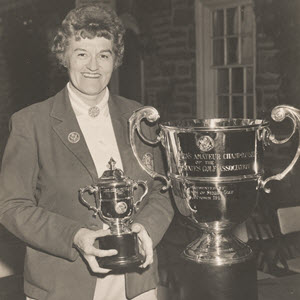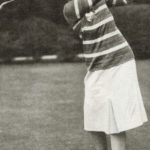
Maureen Orcutt (2021)
About Maureen Orcutt (2021)
Ten Women’s Met Amateur championships, the first in 1926, the last in 1968. Six Women’s New Jersey Amateur championship, the first in 1924, the last in 1967. Seven Women’s Eastern Amateur championships, over a mere 24-year span (1925-1949). Four Curtis Cup appearances, winning five of her eight matches while the U.S. side won three and tied one. Twice U.S. Women’s Amateur runner-up, and three-time medalist or co-medalist in stroke-play qualifying. The first U.S. Senior Women’s Amateur champion, runner-up the next year (after an 18-hole playoff and four extra holes), champion again three years later. Sixty-five significant tournament victories, and innumerable club championships – the last of those in 1989 at age 82. And as if that weren’t enough she was also a pioneering sports journalist, most prominently at The New York Times, where in 1937 she became just the second woman ever to join the sports department, retiring thirty-five years later.
Never has “Golfer of the Century” – the title bestowed upon Maureen Orcutt by the WMGA – been more literal, or more appropriate.
Orcutt was born in Manhattan. Her father was a Mayflower descendant and an editor at The New York Times and The Wall Street Journal, her mother an avid golfer from Sligo, Ireland. In a story recounted by Frank Litsky in her Times obituary, when Orcutt was thirteen her mother did well in the club championship. “If you can be runner-up for the club championship,” Maureen told her, “I can win it.”
“You are a fresh brat,” Elizabeth Kelly Orcutt replied. “If you can beat me, I’ll give you my golf clubs and my membership at the club.”
Maureen borrowed her father’s clubs and won the match and her mother’s equipment and membership. Elizabeth never played golf again.
The younger Orcutt gave up the game, too – but not until she was in her late 80s, and could no longer enjoy the physical effort involved in golf. But she still reveled in it, and gladly met with younger players and sportswriters who visited her in her retirement in Durham, N.C.
She grew up in Englewood, N.J., beginning her long string of golf victories and also captaining the girls’ basketball team at Englewood High. She injured her knee in gym class during her first year at NYU; a doctor told her to recuperate in Florida’s warm climate, and she agreed – and never returned to college. She did come back to the Met Area, however, and covered golf for a variety of newspapers and magazines; her assignment when she joined the Times was a column entitled “Women In Sports.”
Her contemporaries were Jones and Hagen, Wethered and Vare, Sarazen and Hollins, Snead and Zaharias. When she overheard Hagen grumbling about being paired with “a lady golfer” at an exhibition in Augusta, she said nothing, but “the next day I carried Hagen for nine holes and we won.” Her 240-yard drives were the equal of many male professionals; The Washington Post described her in 1927 as “tall, blonde, determined – the sort of woman the Vikings would have admired.” When she beat Zaharias in one exhibition match, the Babe stalked off without settling their $10 bet.
Since she was an established athlete when she shifted to journalism, the Times allowed her to continue competing while writing for the paper. Her interests came in direct conflict more than once; Rhonda Glenn wrote in Orcutt’s USGA obituary that she was supposed to report on the Women’s Metropolitan Amateur in 1968, but when she reached the finals she called the office and said, “I’m not covering the final, send somebody.” Deane McGowen wrote up the match as Orcutt, then playing out of White Beeches, extended her record in Met Am finals to 10-2 with a 1-up victory.
The most coveted title in her prime was still the U.S. Women’s Amateur – “If there had been a women’s pro tour back in the early ‘30s, I might have turned pro. But there was no money in golf then,” she told Gordon S. White, Jr. She was considered an exceptional long-iron player, but her putting could be suspect on occasion. Herbert Warren Wind, in his book The Story of American Golf, called her “golf’s hard luck girl… [she] could win everything but the national championship.” She lost two finals — 5&4 to Miriam Burns Horn in 1927, and 4&3 to Pamela Barton in 1936 – which made it especially sweet when the USGA created the Senior Women’s Amateur Championship in 1962, and Orcutt became its first winner. She cried with joy at the victory and told a USGA archivist decades later, “It was the thrill of my life because I’d finally won a United States championship.”
Orcutt was briefly married in the 1930s, a union that ended in divorce after less than two years. Her life, passion, vocation and avocation always revolved around golf, and no one, man or woman, has ever competed as well as long as she did. And only Bernard Darwin – the English one-time Walker Cupper who played in the (British) Amateur Championship 26 times – can match her in writing about the game and playing it at a high level. Her omission from the ranks of the World Golf Hall of Fame is an oversight that must be rectified; her inclusion in the MGA’s Hall of Merit is a prestigious honor but for now also a consolation prize.
From a teenage standout to U.S. Senior Amateur champion. . .
Maureen Orcutt’s life, passion, vocation and avocation always revolved around golf, and no one, man or woman, has ever competed as well as long as she did. A talented competitor and golf journalist, Orcutt’s achievements throughout her entire life are as impressive as they come.
ADDITIONAL DETAILS & MULTIMEDIA
Life Events
- Date of Birth: April 1, 1907
- Date of Death: January 9, 2007
- Hometown: Englewood, N.J.
Achievements
- Winner of 65 significant tournament victories and innumerable club championships
- A pioneering sports journalist, most prominently at The New York Times, where she was just the second women to join the sports department.
- Named the ‘Golfer of the Century’ by the WMGA.
- The WMGA’s junior championship is named for Orcutt: The Maureen Orcutt Trophy Tournament and is annually played at her home club, White Beeches



